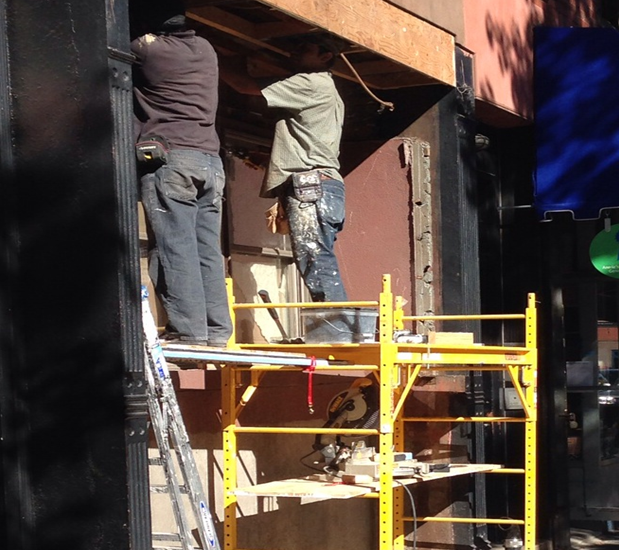Spot The Safety Violation: Proper Equipment Prevents Injuries
Are these workers using this scaffolding properly’

Employers must provide workers with equipment that’s suited to and adequate for the job and ensure that they use this equipment properly and safely. In this picture, a scaffold is probably the correct equipment for this job. But it either isn’t wide enough for both workers to stand on or they’ve improperly positioned it so that only one worker can use it. To compensate, the workers have rigged up a wooden board to extend from the scaffolding and on which the second worker is standing. That’s not a safe alternative.
Instead, the workers should get a wider scaffold or reposition the one they have. Another possible option would be for the second worker to stand on the stepladder that’s leaning against the wall in the picture rather than on the pirate-like plank they’ve set up.
Failing to provide workers with equipment that’s appropriate for the jobs you’ve asked them to do can lead to injuries and OHS violations.
Example: A hatchery worker fell and broke her leg while climbing out of a storage trailer. The top of the portable steps to the trailer was two feet lower than the trailer’s floor. The hatchery, which was convicted of a safety violation, said the steps were ‘adequate.’ But the court disagreed, noting that a two-foot gap between the top step and trailer was ‘self-evidently unsafe’ and ‘an accident waiting to happen.’
By supplying workers with a set of steps that was too short to access the storage trailer safely, the hatchery failed to take every precaution reasonable to protect its workers’which includes providing equipment that’s adequate for the task for which it’s required [Ontario (Ministry of Labour) v. Stratford Chick Hatchery Ltd., [2012] ONCJ 47 (CanLII), Jan. 30, 2013].
You must comply with the specific requirements for scaffolding in your jurisdiction’s OHS laws. But here are 14 basic scaffold safety tips:
1. Scaffold erection and dismantling must be done or supervised by qualified workers.
2. All scaffolds must be inspected before use by a competent person as well as those who will use them, regardless of who erected them.
3. Damaged or weakened scaffolds shouldn’t be used until they’ve been effectively repaired.
4. All erected scaffolds must be plumb and level.
5. A scaffold must be designed and appropriate for the intended use.
6. The vertical supports of scaffolds must be placed on a firm base or sill.
7. The scaffold must be capable of supporting at least four times the load that will imposed on it, including workers, tools and materials.
8. Scaffolds should have toe boards to prevent tools and materials from falling off them and endangering workers or others below or nearby.
9. The scaffold supports must be properly braced.
10. Don’t use pallets, boxes, concrete blocks, bricks or other unstable materials to support scaffolds.
11. The wheels of rolling scaffolds must have locking devices or blocks to prevent movement.
12. Scaffolds should have guardrails if workers are at risk of falling three metres or more or workers using the scaffold must wear appropriate fall protection.
13. Keep scaffolds’especially those made of metal’away from power lines.
14. Avoid using scaffolds in high winds.